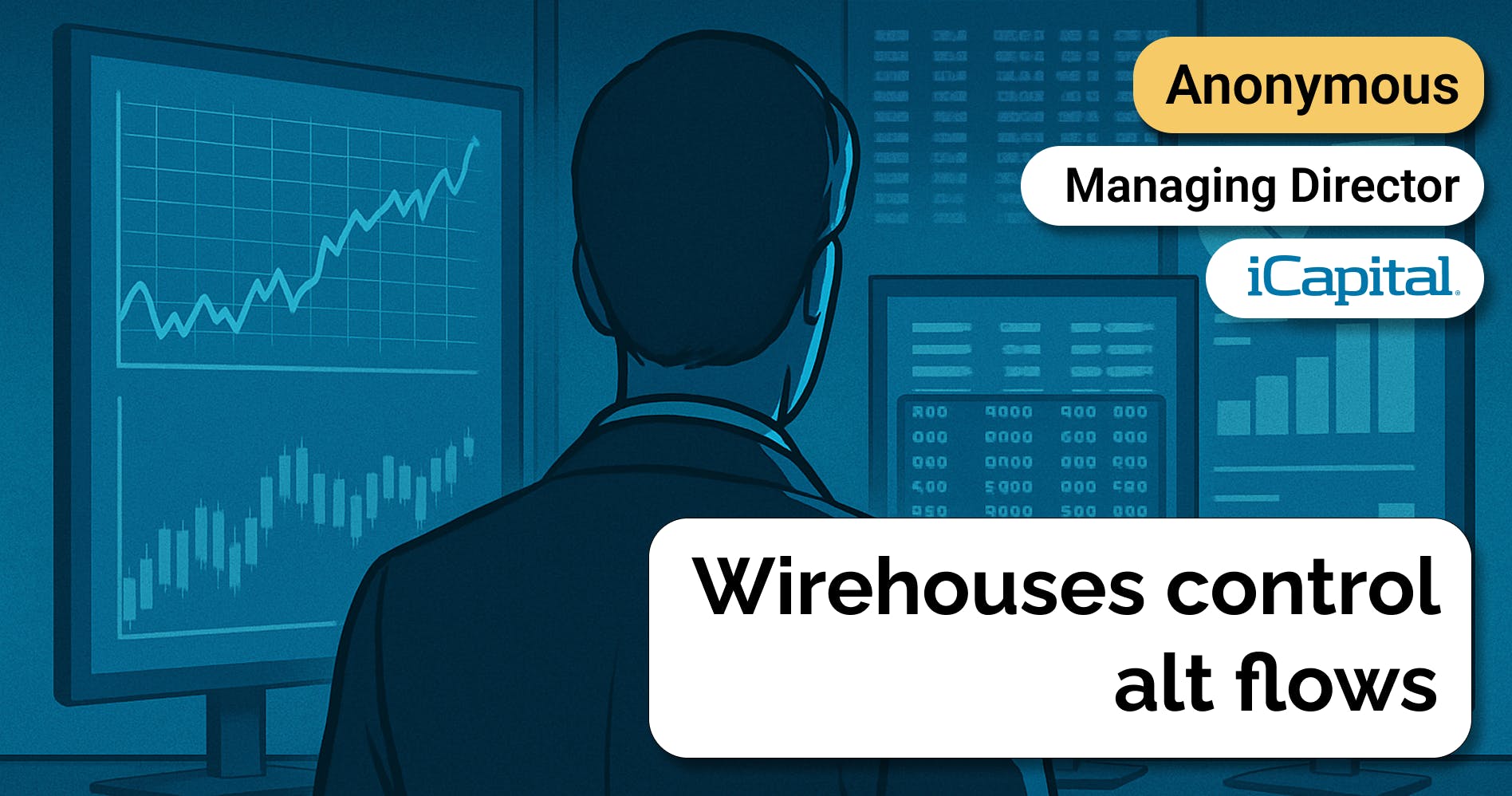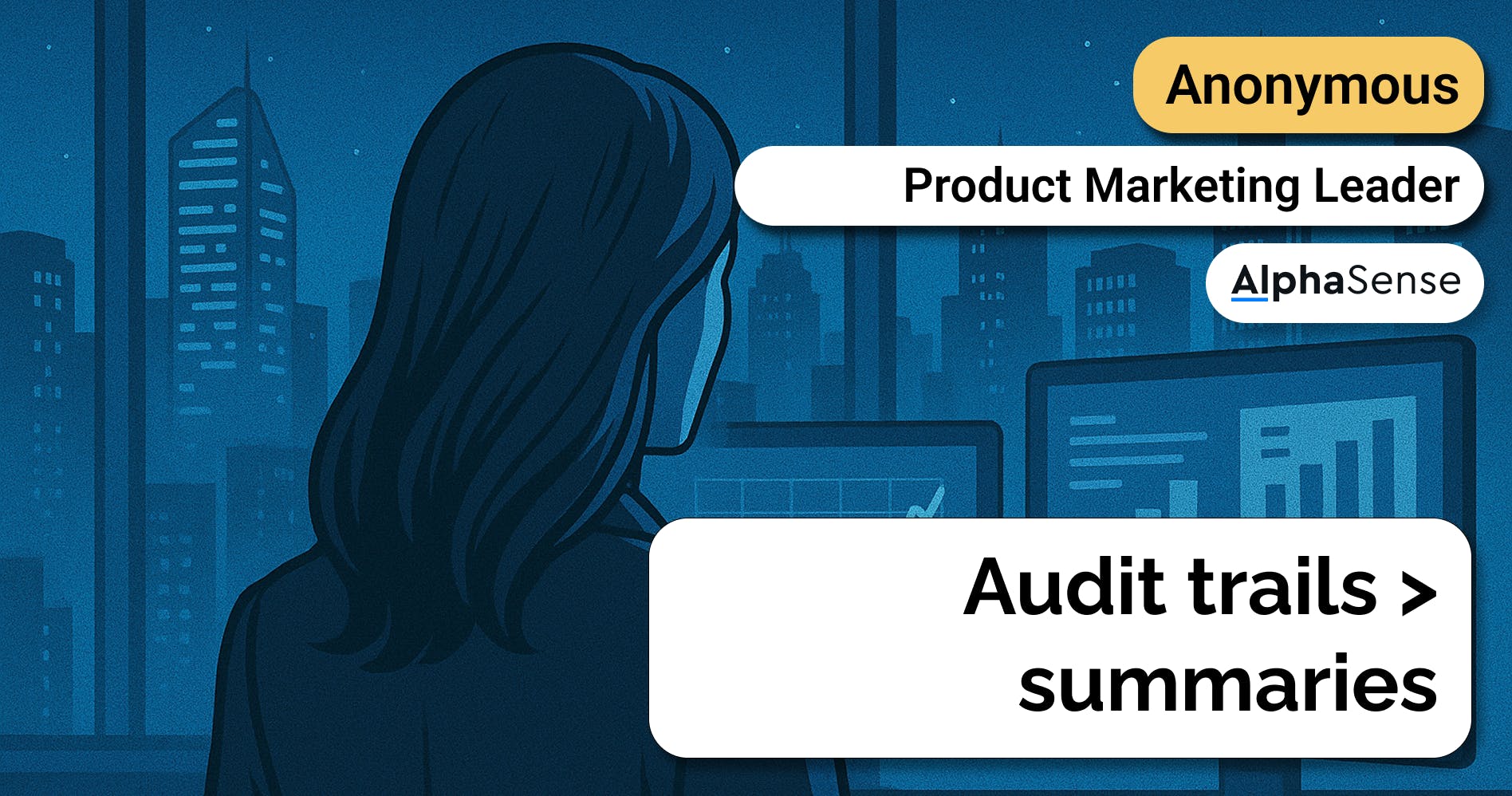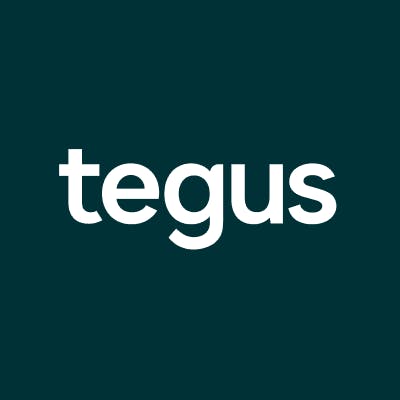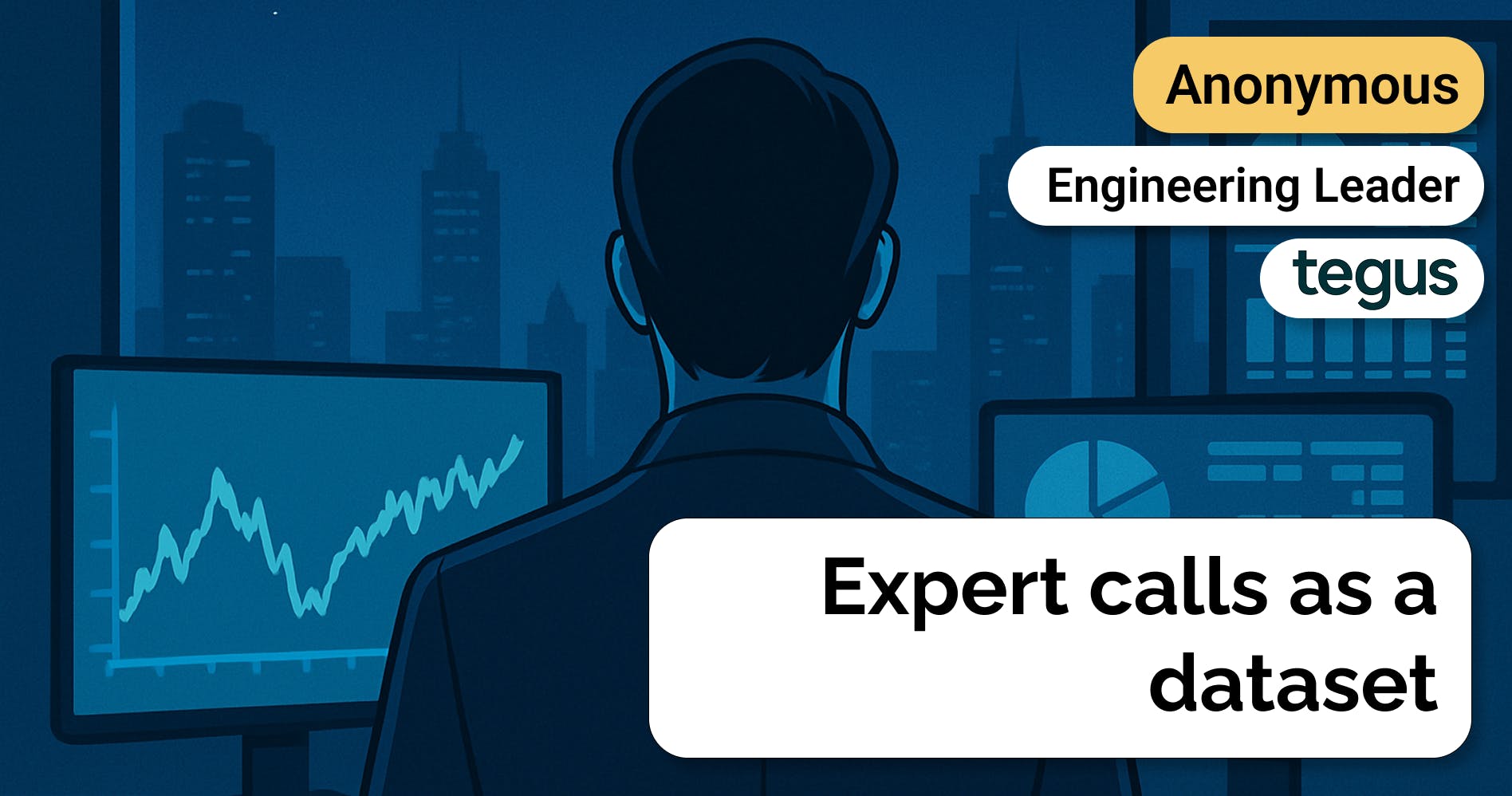Managing Director at iCapital on how evergreen funds are eating private market share
 Jan-Erik Asplund
Jan-Erik Asplund

Questions
- What are the main customer segments at iCapital, and how do their use cases and needs overlap or diverge?
- Yeah, it does. Just to make sure I understand the moving parts, roughly speaking, to the extent you're able to answer, what would be the rough percentages of these different segments? So to subdivide it in one way, you have Blackstone and others that are offering funds, and on the other side the UBSs and Morgan Stanleys on the other side—and direct to RIAs as well. What would be the rough breakdowns of the different buckets?
- Is there one that was dominant or just seemed more important?
- You've outlined this very core functionality where iCapital is allowing funds to access these broader pools of capital. It's powering the subscription and back-end process of those relationships and just removing a lot of the complexity and fragmentation out for the fund, the advisor, and the end investor. Is that really the core value driver? To what extent do portfolio analytics or research, due diligence, reporting—to what extent do those features also become core to the package for the demand side?
- Would dashboard or presentation aspects be different in the two cases? One where you’re managing many investors' investments via iCapital and trying to get a picture, what everyone holds, etc.—then you would have one view. But if you're that end investor, working with an adviser, and you're accessing a fund through iCapital, you would have a different view of the data that would cover only your own individual holdings. Is that kind of how it works?
- Is Addepar a company that would overlap with iCapital and be competitive in some aspects? What tools are typical for some of these customers to have and how they would stand apart or be competitive with iCapital?
- What are some other typical tools that customers had in their stacks to complement iCapital? For example, that integrated directly or maybe were just not integrated but complementary. Are there any that come to mind?
- In terms of asset classes. Is it overwhelmingly PE, real estate? What am I missing?
- Oh, no. It was about asset classes, but you mentioned a couple of times it was really private credit, real estate, and PE. To what extent, if any, do VC investments play a role in this mix?
- What were the big product or strategic shifts that you observed at iCapital?
- It sounds like that would lead to different monetization/pricing and business models. I assume that if a fund is going direct, then it's more of a software subscription. And then if they're participating in a feeder fund, then there's transaction sort of transactional and management fee type pricing. And maybe there's both in some situations. How would you describe it?
- You mentioned earlier that there were competitors in terms of the feeder funds. In terms of the direct fund stuff, were there a lot of competitors there too? Would it be possible for you to name some typical or representative competitors for both lanes?
- What are the synergies iCapital gets from managing these feeder funds? Is it a plus because it's generating data, generating some sort of user network effects, for the core software platform. Is that one way to think about it?
- So to paraphrase, having that relationship with all these administrators on the feeder fund side and connecting them to pools of retail capital, means that iCapital owns these relationships with two sides of the marketplace. So, obviously, if you're running a software business where you're helping both sides of a marketplace interface, having a close relationship with a huge volume of participants is going to be beneficial. Is that fair?
- If you were sitting and needing to analyze opportunities in the wealth space for companies like ICapital or adjacent companies, what do you think are core trends to watch?
- One quick follow-up. Why would the return profile be different? Because of just not having guaranteed capital for a guaranteed time horizon, and having to manage those time offsets?
Interview
What are the main customer segments at iCapital, and how do their use cases and needs overlap or diverge?
That’s a very good question. Because it’s not a simple answer. People would always ask me, "Who are iCapital's clients?"
Because iCapital faces off with everybody in the alternative investment landscape, so iCapital could have a number of different clients.
In many cases, it might be a large wirehouse firm. For instance, Morgan Stanley, Merrill Lynch, UBS—all of these firms use iCapital to better enable their advisers to offer alternative investments to their clients.
So Morgan Stanley might say, "There's this great new hedge fund. We want our advisers to be able to offer this hedge fund to our clients," or "There's this great new private equity fund. We want our advisers to be able to offer that to our clients." In those cases, they might try to go directly to the fund and say, "Can you take our clients directly?" But in many cases, the funds themselves aren't really set up to take a thousand Morgan Stanley investors or a thousand UBS investors. And in that case, they'll say, "No, you have to come through a feeder fund." If in those cases, all of those firms would go to iCapital to make that happen, to basically create the fund and manage the fund for them. So in that case, Morgan Stanley is iCapital's client, and their clients are the end investors in the iCapital-run fund.
But in other cases, you might have a Blackstone who says, "We want to offer this fund to a different subset of private wealth investors." And maybe it might be Morgan Stanley, or maybe it might be all the RIAs that are out there, or just getting it out in the marketplace so that advisors can offer to their clients anywhere.
And in those cases, Blackstone would come to iCapital and say, "We need you to create this fund, and we want you to run this fund for us." And then iCapital would take all of the assets into that fund and then invest it back into the Blackstone fund. But Blackstone, in that case, is the client.
Now, Blackstone would go and sell that fund. They'll sell that fund to maybe UBS or maybe to Morgan Stanley or maybe to both and maybe to Hightower and all these different RIAs. All of those firms would then come into that Blackstone fund. But at the end of the day, Blackstone is really iCapital's client, but we're working and facing off with all of those different firms.
Those would be the biggest subsets. The other thing, though, is iCapital also has good technology for managing the subscription process. So there are a number of firms where iCapital actually doesn't manage the fund, but that fund is available through the iCapital platform to better facilitate subscriptions into the fund. And so in that case, whoever that fund manager is would also be the client. But does that answer the question?
Yeah, it does. Just to make sure I understand the moving parts, roughly speaking, to the extent you're able to answer, what would be the rough percentages of these different segments? So to subdivide it in one way, you have Blackstone and others that are offering funds, and on the other side the UBSs and Morgan Stanleys on the other side—and direct to RIAs as well. What would be the rough breakdowns of the different buckets?
That's a good question. Honestly, I don't have an answer to that. That would be difficult to say. I don't have a good breakdown.
Is there one that was dominant or just seemed more important?
Blackstone is probably the biggest relationship. But then you would look at a firm like Millennium, which is a very large hedge fund, and iCapital is actually the largest investor in Millennium. But iCapital is invested in Millennium for the benefit of Morgan Stanley clients, Merrill Lynch clients, UBS clients.
So in those cases, those other firms are actually the iCapital client and iCapital would be investing in Millennium. And then iCapital offers that same fund to all different RIAs and all that sort of stuff. So that's a huge relationship as well.
But as far as dividing it up, I honestly would be just guessing at what the percentages are.
You've outlined this very core functionality where iCapital is allowing funds to access these broader pools of capital. It's powering the subscription and back-end process of those relationships and just removing a lot of the complexity and fragmentation out for the fund, the advisor, and the end investor. Is that really the core value driver? To what extent do portfolio analytics or research, due diligence, reporting—to what extent do those features also become core to the package for the demand side?
No. All of that is part of the package. You nailed it.
iCapital—it's funny if you go way back—actually stood for institutional capital. And initially, it was created to connect institutions with private equity funds. But they quickly realized that there was very little that either one of those entities would want to pay anything for that service.
And so then it quickly changed to the private wealth markets. This is going way back. I mean, that was the very beginning of the firm. And then it very early on changed to the private wealth market.
Initially, it was a feeder fund business. That's what iCapital did. But Lawrence Calcano, the CEO, made some really excellent smart moves along the way. And one of those was a pivot toward being more than just a feeder fund firm, but also being really the one stop for advisors no matter where they're sitting—at a bulge bracket firm or at a mid-tier broker dealer, at a small RIA, at a large RIA.
He wants every advisor, if they want to do something in alternative investments, for iCapital to be the dashboard. That's where they go to get anything done in alternative investments, which also includes the structured notes business, which iCapital got into.
And then you have to look at the whole value proposition of that and the whole chain of how that comes about. And education is huge among advisers as to what they need to see to facilitate trades into these funds.
There was a study actually on the website, the iCapital website. Basically, it was saying that education is one of the main drivers—understanding how alternatives impact overall portfolio construction. Those are some of the sticking points as to why advisors might not get their clients to invest in alternatives.
And access to institutional quality alternative investment products is another. And that's what iCapital has always traditionally solved through the use of feeder funds.
But then in terms of educating people on the alternatives market, in terms of educating people on individual funds, and then to your point, to be able to demonstrate what the impact on someone's portfolio would be is a huge driver. And so all of these things, iCapital has targeted.
And then—if you know much about this universe—if you go back ten, fifteen years to invest in one of these funds, somebody would have to, if you were lucky, email you a PDF, and then you'd have to print the PDF, and you'd have to go through, and you'd have to fill out all these pages, and you'd have to initial here and check there. And then you'd maybe scan it back in and send it over to the administrator, and the administrator would go through it. And they would say, "Oh, you forgot to check—you forgot to put a check mark on page 27. You forgot to answer this question." And so the person would have to go through it again, fill it all out, and then scan it back in, send it back.
That's how this business was really clunky, and these are 60-page documents that you're going through as a subscription document.
iCapital has made it much easier, and there are others. There are a lot of competitors in this space. I don't think anybody touches iCapital in a lot of the other portions. But in the space of allowing people better access and easier methods to subscribe to funds, there are competitors.
But at iCapital, they have a great system. So if you're an advisor and you want your client to invest $100,000 in XYZ PE fund, hopefully, you would have that investor already—a profile of that investor already on the iCapital platform. And then it's as simple as, "I want this investor to invest $100,000," and then the iCapital platform would create and completely fill out the subscription document. And then you as the adviser would send it off to your client to sign it electronically through the iCapital platform, then it would get sent over to the administrator along with a metadata file that has all the data from that subscription.
So it's not like in the old days, right, the admin would have to go through and write down all of and create their own profile on their side from the data that they scraped out of this document. Well, they're getting all that data now through a metadata file. So they can create the investor very easily. And they'll know that it never left the iCapital platform or ecosystem, and so there's no—it makes things a lot easier for the admins as well.
So all of this plays in. And then in terms of reporting, that's the next thing. Once a person is subscribed—well, I should say also, the iCapital platform has the ability for the admins to say, "This person forgot to check box whatever." That can still happen on occasion. It shouldn't happen nearly as frequently if you create the subscription through the platform, but it can still happen. And but there's the ability to have the documents remediated right through the iCapital platform, which again, makes things a lot easier.
So the adviser would see, "Wait. This investment didn't move from legal review stage to approved stage. It moved from the legal review stage to the requires attention stage." And so the adviser knows to go back in and see what they need to correct in the profile to get this thing corrected.
So that really takes a lot of the friction out of that subscription process.
And then from there, there's reporting, monthly or quarterly reporting, position and activity reporting. iCapital platform is very plugged in. They've integrated with a lot of the admins so that the reporting all comes—is much easier for the clients to digest from coming from iCapital.
So that's certainly another huge benefit. And then to show the advisers a full picture of what your client holds in alternatives is another major benefit as well.
Would dashboard or presentation aspects be different in the two cases? One where you’re managing many investors' investments via iCapital and trying to get a picture, what everyone holds, etc.—then you would have one view. But if you're that end investor, working with an adviser, and you're accessing a fund through iCapital, you would have a different view of the data that would cover only your own individual holdings. Is that kind of how it works?
Correct. Yeah.
Is Addepar a company that would overlap with iCapital and be competitive in some aspects? What tools are typical for some of these customers to have and how they would stand apart or be competitive with iCapital?
So Addepar—again, I'm not deeply knowledgeable of Addepar or their business model. But Addepar would tend to compete with iCapital in some of the aspects, namely the reporting once you're invested from what I understand. And potentially have the ability to show the impact of an investment prior to investing. So they may be able to do that as well.
From my understanding, though, they're not going to get you access to funds, and they don't, from my understanding, offer the ability to facilitate subscriptions into funds. I view them more as sort of a back-end reporting ability, which again, iCapital has. And I should say also, one other thing that we've missed on iCapital is they've got a great document center.
So all of—if you have funds, if you're an advisor, your client has funds at a number of different places where you can go to the iCapital document center and get the statements from those funds and any other materials from those funds, in one location regardless of who the admin of that fund would be. So that's a huge benefit.
But yeah. So Addepar, I believe, in a lot of cases, iCapital would report to Addepar for the benefit of certain advisers. They might want to include an Addepar address on their subscription for iCapital to send information so that it gets into the Addepar platform. So that's where you'd see an Addepar.
So they would be competing in some aspects of what iCapital does, but I don't believe would have nearly the breadth of services that an iCapital has.
What are some other typical tools that customers had in their stacks to complement iCapital? For example, that integrated directly or maybe were just not integrated but complementary. Are there any that come to mind?
I wasn't as close to that, to be totally honest. So I don't really have a great sense for that. I know we sent data to a number of different third party providers similar to an Addepar, but I wasn't as involved in that aspect.
In terms of asset classes. Is it overwhelmingly PE, real estate? What am I missing?
So what you've seen in the private wealth space for these private assets, is that—and really, in my mind, Blackstone sort of led the charge in this area. They were probably the earliest of the major private equity, private real estate, private credit firms to begin to target the private wealth markets.
And if you step back further and you look at it, the private wealth markets globally are roughly the same size as the institutional markets. iCapital's got some data on their platform that you could take a look at. But they're roughly the same size globally.
So those firms—the large Blackstones and whatever—that traditionally only targeted the institutional investors were leaving out half of the global potential marketplace.
And so, I believe Blackstone was sort of the earliest to really realize that and to begin to target that space. And one of the things—so early on, there were again, that's where iCapital would create a feeder fund for different funds, and that's because these funds were all structured as private funds relying on the SEC's 3(c)(7) exemption, so that they could—and but in relying on that, you're limited to 2,000 investors, which makes every slot very important for a Blackstone.
I mean, they don't want to sell or give away one of their 2,000 slots in this new fund that they're coming out with to an investor that's going to give them $100,000. It's not worth their time. So that's why Blackstone would traditionally only talk to a person if they had $50 million, whatever the number might be.
Blackstone realized that there was this huge market out there for private wealth assets that they were not getting involved with. And so they started targeting that. They created, with Morgan Stanley, Merrill Lynch, all these firms, they created feeder funds to go into these Blackstone funds.
But then they came out with a better product finally, which was the Blackstone Real Estate Investment Income Trust. And it had tremendous success. And why did it have tremendous success in that retail or private wealth space?
Well, if you look at it, number one, it wasn't a private fund. It's registered actually with the SEC. And so, therefore, there's no limit on the number of investors it could take.
The other thing was in the private wealth space, if you're an adviser or you're a private investor, having to—that drawdown structure is problematic. If you're an institutional investor, you can manage that liquidity much better. Whereas for an adviser managing his client's assets and that client having to deal with it. And, oh, by the way, if you get—if, let's say, this underlying Blackstone Fund has ten days to turn around a capital call and send them the money—ten business days. Well, on the feeder fund side, they need time on both ends to get things together to send out the same capital call for their clients and then to process it and send that money back to Blackstone in this case. So there's typically a five day turnaround on that side. That's really difficult for an adviser.
So Blackstone actually came out with—they had this REIT, which real estate assets typically were held in a drawdown structure. Well, BREIT has monthly liquidity, so you can get your investors invested into this thing every month. And it's fully funded upfront, so you don't have to make a commitment and then send money in whenever the fund wants you to send money in. You can send money in at the end of every month.
And, oh, by the way, if you're an advisor and you get your client into one of these funds and your client needs some liquidity, in a traditional old school real estate, private real estate, private credit, private equity fund, you can't redeem when you want to redeem. BREIT solved that by saying, "You can redeem at the end of every month." Now, obviously, there's some parameters around that. It was only 2% per month that they would allow of the fund to redeem. But in most months, they don't come near the 2%. And so if you want to get out of that fund completely, you could get out at month end.
This structure solved so many different problems for private wealth advisors and investors. And it was then sort of replicated to BCRED at Blackstone, and then every one of Blackstone's competitors basically came out with the same product. It's a much better way to go after that retail/private wealth marketplace.
And I went off on a tangent. I'm forgetting what the initial question was.
Oh, no. It was about asset classes, but you mentioned a couple of times it was really private credit, real estate, and PE. To what extent, if any, do VC investments play a role in this mix?
VC hasn't really made as many inroads that I've seen certainly, in the private wealth space. VC is probably inherently riskier. And I haven't seen as much—iCapital didn't really work with a lot of VC in early stage investment funds.
What were the big product or strategic shifts that you observed at iCapital?
Well, the biggest thing is what I just shared with you. That shift from private funds that require feeder funds—because if, again, if you have that 2,000 investor limit, you're going to need a feeder fund because to take all the small investors, if you want to be able to offer it in the private wealth space. So that shift, number one.
And then the other big thing was the shift from the old school drawdown funds to evergreen/semi-liquid funds. And that was really a big shift in the marketplace.
And then but then if you step back from iCapital's perspective, there's—when you when you go to a registered fund and you don't have that slot limit issue, now all of a sudden, Blackstone, for instance, with BREIT, they can take thousands and thousands and thousands of Morgan Stanley investors directly into their own fund. And so there then there's less need for—there's no need for iCapital to create a feeder fund.
Now we'll get back to that in a second because iCapital does have feeder funds into BREIT. But for the typical US investor, there's no need for anybody to set up a feeder fund to go into BREIT. They can—these investors, the advisers can get their clients to invest directly in BREIT without going through a feeder fund. That's a change. That sort of disintermediates iCapital in some of these funds.
And so iCapital needs to play—wants to play a role in there, and they can play a role in everything other than managing that fund. They can still and they do work with a lot of advisers, as a front end system to get them to invest into BREIT. And then there's all the reporting and everything coming out. So they can still play a role, but they're not having to create a feeder fund.
Now the one exception again, though, in terms of BREIT and all of their competitors was, Blackstone came to us at iCapital early on and wanted iCapital to create an offshore feeder. So a Cayman Island feeder into their BREIT product to allow for non-US investors to invest in BREIT. That was a huge success for Blackstone and for iCapital. They did—Blackstone came in with BCRED, did their private credit fund, did the same thing, and every one of Blackstone's competitors came to iCapital and asked for iCapital to create the same thing. So that's a huge—that's been a huge business and a huge success for iCapital.
But in getting back to it, iCapital needs to figure out—it has, and has some good offerings, but is working diligently with all of its clients on adding value in that direct fund space where there is not a need for iCapital to create a feeder fund.
It sounds like that would lead to different monetization/pricing and business models. I assume that if a fund is going direct, then it's more of a software subscription. And then if they're participating in a feeder fund, then there's transaction sort of transactional and management fee type pricing. And maybe there's both in some situations. How would you describe it?
Yeah. You nailed it. Obviously, on the technology side, there's—the benefits for iCapital are there's very little manpower needed, once that fund is set up. Everything's automated, so it's very scalable. But again, it's lower fee. You're getting paid less on the assets in those types of arrangements.
Managing a feeder fund takes a lot of manpower. There's a lot that iCapital is doing to generate scale on that side of the business, but it still requires quite a bit of manpower to run these funds. So while you're getting paid more, your cost to manage those assets are quite a bit higher.
So it's a constant balance.
You mentioned earlier that there were competitors in terms of the feeder funds. In terms of the direct fund stuff, were there a lot of competitors there too? Would it be possible for you to name some typical or representative competitors for both lanes?
Yeah. I mean, on the feeder fund side, there's probably less competitors. You have CAIS creates feeders. And then you also have—I mean, the fund manager themselves can run the feeder.
What you found is mostly if—the large pretty much all the broker dealers now, the significant ones, realize that running a feeder fund is just bad business for them. It's very difficult. And so they—there's less competition from people from firms wanting to do it themselves on that side. So for instance, UBS sold their entire feeder fund business to iCapital. Morgan Stanley did the same. Merrill Lynch did the same. Wells Fargo did the same. All these firms realize that they don't add value running that fund. So they—so iCapital does that.
But you can see sometimes—the large general partners might decide rather than having an iCapital manage the feeder fund for them that they might want to manage the feeder fund internally. Again, it tends to be very different than what a lot of these managers are used to. So there's not many of them that choose that, but they could choose that. So that's one area of competition.
CAIS does offer some feeder fund capabilities. They're not nearly at the scale. But I'm not really aware of too many others that would actually run feeder funds for these firms. I know SS&C at one point was sort of talking about trying to do it themselves. And then they've since pivoted and now want to work with iCapital.
So there's—I believe, less competition on the actual feeder fund side. There was another firm called Altegris that did it, and they sold that business to iCapital.
And then but then on the software side, there is more competition because you've got, again, an Addepar covers some of it. CAIS, which we discussed, they're not only a competitor on the feeder fund side, but in terms of technology. And then you've got a number of others, Yieldstreet or Fundrise or there's other firms, Subscribe, something. There's other firms that offer the subscription—the subscription software for subscription process, that type of stuff.
And many of the admins themselves have those capabilities and a lot of the same reporting capabilities that an iCapital have. So there would be more competition on that side.
What are the synergies iCapital gets from managing these feeder funds? Is it a plus because it's generating data, generating some sort of user network effects, for the core software platform. Is that one way to think about it?
Yeah. What—if you step back, why would a Morgan Stanley sell that business to iCapital? They determined—iCapital, at the end of the day, is a fintech company. These firms realize that iCapital can do a better job managing their clients in these products than they could themselves through the technology that iCapital has and the integration work that iCapital has done with these administrators.
And it allows Morgan Stanley, for instance, to face off with just one party rather than having to face off with all these different administrators. They can leave facing off to all the different administrators to iCapital, and they just have to deal with integrating with iCapital. So that's really the benefit of it.
And then it doesn't really matter who, for them, who is managing that fund and who the administrator of that fund is because they're just facing off with iCapital. So that's where you get sort of those synergies.
And but it—having that relationship just is a big benefit to iCapital. And it all kind of melds together.
So to paraphrase, having that relationship with all these administrators on the feeder fund side and connecting them to pools of retail capital, means that iCapital owns these relationships with two sides of the marketplace. So, obviously, if you're running a software business where you're helping both sides of a marketplace interface, having a close relationship with a huge volume of participants is going to be beneficial. Is that fair?
Yeah. Yeah.
If you were sitting and needing to analyze opportunities in the wealth space for companies like ICapital or adjacent companies, what do you think are core trends to watch?
So you're—what you're starting to see is, it started with the biggest and the best, private asset general partners targeting this space. And you're starting to see that slowly trickle down to smaller and smaller firms. For instance, I know of a $6 billion real estate firm. They've got a great track record and great pedigree, great name in the institutional space, and they're looking at now how—trying to figure out how they can start to crack the private wealth space.
So you're seeing that, you're starting to see more of the mid-tier managers looking at accessing this space. That's one big thing going forward.
It will be very interesting to see over time the—and I'm sure everybody's going to be looking at this closely over the next few years, just how the returns stack up for these semi-liquid funds versus the old school drawdown funds and how those returns stack up. You'd expect the old school drawdown funds should outperform. And if they do, well, how much is that? And are people willing to continue paying whatever that premium is for the liquidity and for the simplification that you find with those semi-liquid evergreen funds.
So that'll be interesting to see and to see. Maybe there will at some point, maybe there'll be a shift back to these private funds, and the drawdown structures if the return differential is great enough.
Those are the two main things I can think of. I feel like I'm missing something, but those are the two that come to mind immediately.
One quick follow-up. Why would the return profile be different? Because of just not having guaranteed capital for a guaranteed time horizon, and having to manage those time offsets?
Exactly. And you've got cash coming in and out of the fund on a monthly basis or coming in monthly, out quarterly. You've got to manage that liquidity. So you've got to—whereas on the drawdown side, you're putting the money to work when you've got a deal.
And so there's less—you know, that's—there there are benefits to that old private structure. And you're going to—there's you may have to—when you've got the evergreen fund, people—there's—you're going to have to have the ability to meet redemptions. So you have to have some of it in fairly liquid space. In the case of most of these funds have a 5% cap on the redemptions out of the fund per quarter, but you still have to manage for that.
Whereas, in that other structure, you don't run into those needs, and you can have a better sense of being able to manage the liquidity of the fund and have it be able to limit what you maybe might put the money that you draw down into.
Disclaimers
This transcript is for information purposes only and does not constitute advice of any type or trade recommendation and should not form the basis of any investment decision. Sacra accepts no liability for the transcript or for any errors, omissions or inaccuracies in respect of it. The views of the experts expressed in the transcript are those of the experts and they are not endorsed by, nor do they represent the opinion of Sacra. Sacra reserves all copyright, intellectual property rights in the transcript. Any modification, copying, displaying, distributing, transmitting, publishing, licensing, creating derivative works from, or selling any transcript is strictly prohibited.













